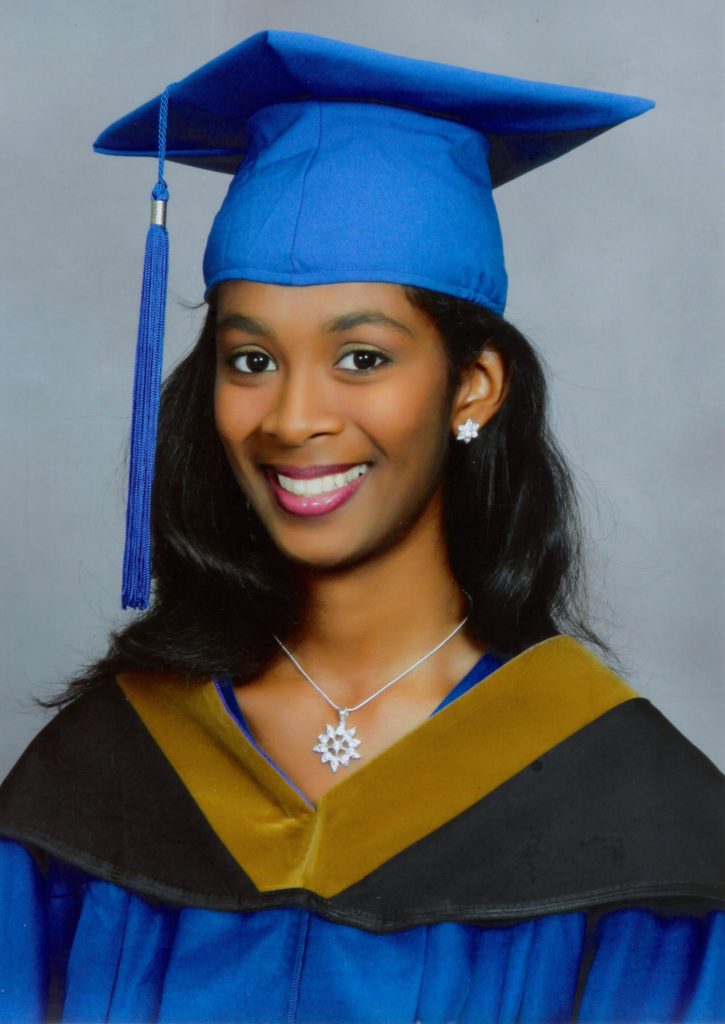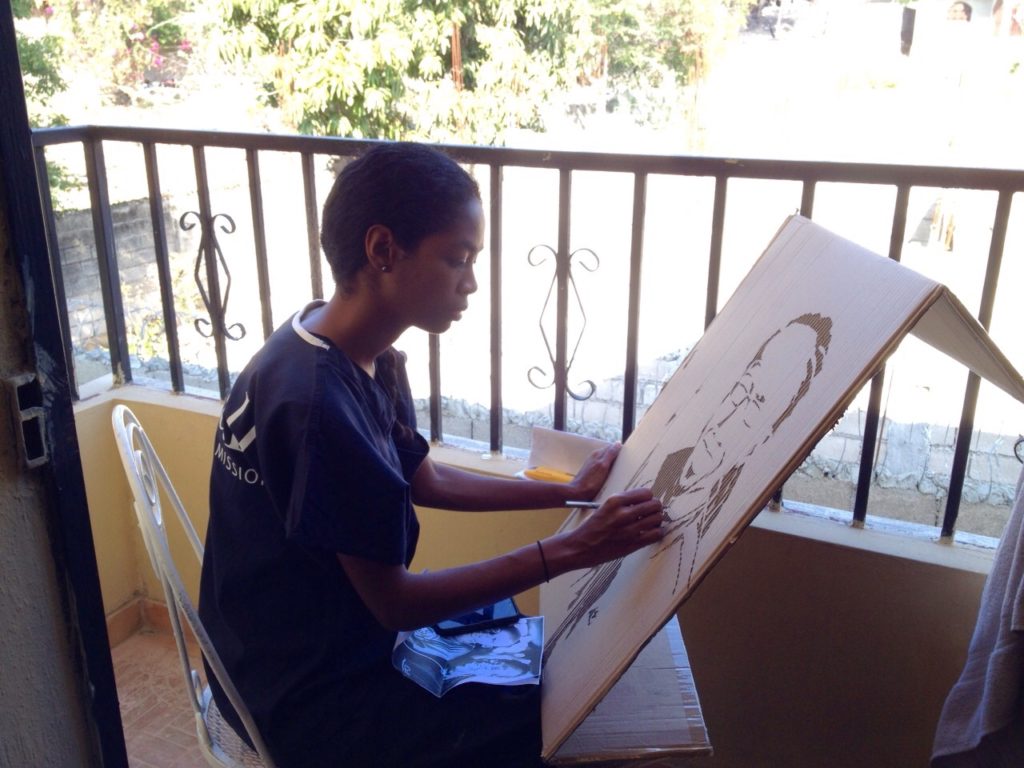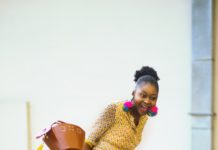In this installment of Our Stories, artist Samantha Hay explains why taking a risk is sometimes the best option…For many people, Jamaica is pictured as an island paradise – white sandy beaches, a beautiful and vivacious culture, rich and wholesome food, and attractive people. And while that image is not far from the truth, if the lens is focused on the inspirational stories of ordinary Jamaicans, you’d find a sharper, richer and truer image of the Jamaican experience…this is Our Stories!
There will always be things that we’re told we can’t do by society, by loved ones, by our own selves. It’s only too easy to let our fear of people’s opinions or of the unknown influence our every decision. But there are some of us who have found the courage to take risks and accept whatever may come on the other side to challenge both the status quo and ourselves, in order to pursue our innermost passions and act on our strongest beliefs.
Meet Samantha Hay

She has dreamed of becoming an artist ever since childhood. Against the wishes of some members of her family, she was determined to turn her dream into reality. Now, years after graduating from Edna Manley College of the Visual and Performing Arts as valedictorian for her year, she works as a graphic designer, illustrator, and owner of the lifestyle and stationery brand, Jamecca Motif.
She specializes in typography and has a passion for showcasing and celebrating Jamaican culture through art. Time and again, Samantha has gone against the grain and faced her fears in the areas of her career, education, social outreach, and life in general.
Growing up, why do you think you chose to become an artist?
I guess I’d describe myself as someone who’s never really fit into a social
And although your parents supported your artistic dreams, did you ever get negative reactions from others?
Oh absolutely (laughs). I think especially going to a school like Immaculate which was, at the time, and still to this day considered the top school in the island and … You know, as I said, I was fairly average to good academically so a lot of family, I guess especially on my mom’s side, a lot of the family that would’ve not been brought up with those kinds of opportunities to go to these, you know, hifalutin schools and all of these resources and all of these opportunities at [their] disposal would’ve looked at myself as someone that was going to do something big with it. Like, ‘Oh yeah, she’s going to be like the doctor or the, you know, the lawyer’ or, you know, those kinds of cliched careers that you expect every child to fall into once they’re successful. And so, I didn’t realize that there was that kind of weight of expectation on me from that side of the family […]
And I think when I mentioned that I wanted to be an artist, they didn’t take me seriously […] But like … I’m happy to say the family is very supportive now. And I think much of it is not because, you know, I stuck to it. But it’s the fact that I proved to them and to myself that it’s lucrative! It can be lucrative to sit down and, you know, work your butt off in something that you’re passionate about and make it work for you. Now I’m working on my own. I’m not working at a 9-5. I’m self-employed. You know, I have my own apartment … I pay my own bills … I’m completely self-sufficient as an artist.
That’s amazing! Okay so just to rewind a bit … After completing high school, you enrolled at the Edna Manley College of the Visual and Performing Arts. Why did you decide to go to that school?
[While still at high school], I ended up enrolling in a part time course at Edna where I got to do A-Level art at Edna Manley on Saturdays. So, [I did] Saturday classes there while I was doing 6th form. And yeah! So that’s how I kept up art for those two years before I graduated. So, by the end of the time at Immaculate, I knew for sure that I wanted to go to Edna Manley. I had fallen so in love with the … The kind of family unit that they had there. It’s not so much the school itself … Because, of course, I barely had a proper grasp of what the school had to offer outside of just a physical infrastructure level. But, I just fell in love with the ambience of the place. I remember on Saturdays, a lot of the students kind of would pass through and they were just VERY friendly and very welcoming. And it was just this atmosphere of feeling like, wow, I belong here. These are MY KIND! (Laughs) Like, these are the people that I can see myself clicking with.
I had so many other friends who were applying to multiple schools locally and abroad and they were doing their SATs and doing all of these, you know, prerequisite exams and preparations to weigh their options. And I just decided, no I just wanted to go to Edna Manley. I applied nowhere else (laughs). And I remember several people at the time thought I was crazy. Like, ‘Sam, you’re putting all of your eggs in one basket. That is not practical’. But I really didn’t want to go anywhere else.
Wow it sounds like a really special place to you. But after going to school there, you started working at a 9-5 job. What was that like?
After Edna … Even during my final year show, I got recruited working at a 9-5 at a printing press. And that was a great experience. But I think by the time I was probably two years in … I knew from the very start that this isn’t where I wanted to be full-time. Like, I’m a creative (laughs). Being [at] a 9-5 at a desk half the time was just not for me. And thankfully, I was still in an industry that was very creative. As much as I was doing print-based work, I still got to do graphic design. I still got to, you know, interface with persons that were creative and I was always interested in working with my hands and so I still got a lot of hands-on jobs while I was there. And, as I said, the networking and the kind of understanding of the different departments was really crucial to what I do now.

So, why did you decide to leave when you did?
It was starting to drain me […] It wasn’t so much [the job itself] as it was [that] I was struggling to balance. And I think that’s something that, as I said, it’s an individual thing for you to determine where your path is, because not every creative struggles with that. I have friends that worked 9-5 and still manage to balance their own personal work to the side. But I was personally, at the time, struggling. I could not … I would go home and be completely burnt out from working. And I would just literally go home, eat, sleep, wake up and start the routine again. So, the idea of there just being this monotony in my routine of a day-to-day kind of drudgery through life … I was like, ‘No. This cannot be what my life is going to be!’ (laughs).
And I was praying about it a lot at the time and just feeling very uneasy about it in my spirit like this was just not it. This is not it for me and I was ready for the next door to open and I was just not seeing a door open (laughs). And at the time, you know, you’re fresh out of school, trying to get your footing. You’re still under your parents’ house, you’re trying to find some sort of independence … You’re still trying to save. So, it’s still dangerous to just get up and take a leap of faith and leave without really having a plan B.
So, what did it feel like finally taking the plunge and leaving, despite your concerns?
I feel like sometimes the more risky things are, is the more exciting they can be. And it sounds weird to say, but sometimes it’s taking those big leaps of faith and seeing how they pan out [which] can kind of give you this rush. And there is this kind of beauty in not knowing every piece of the puzzle, kind of thing. Like, the opportunity to discover for yourself what the next step will be without someone handing it to you […] You know, there’s kind of these lists of expectations and then for me, I just never felt like I had really just sat and made a decision on my own that I was just going to have to deal with.
And so, at the time when I had left, it was a big leap of faith. Like literally and figuratively. And, I don’t know, I just had prayed that God would know what He was doing when He gave me that urge to leave (laughs). And He did! […] And just so many things happened that couldn’t have happened if I was working a 9-5.
One of those things you were able to do, once you went freelance, was to travel to Haiti on a mission trip. How did you get that opportunity?
Well it was a medical mission trip facilitated by Times Square Church in New York. So, I actually have a family member that works with Times Square Church and she saw a series that I did while I was at Edna … A cardboard series … And [she] was really interested in commissioning me to do some pieces for the medical team that they have in Haiti. So, they had this clinic in Haiti that they had set up from 2010 from the major earthquake disaster. And the clinic is run by Haitians all year round … But every month, I believe, they send a mission team from New York to kind of help them and provide additional resources and additional expertise to help with the outreach for the community, ‘cause it’s a free clinic. And so, they bring medical supplies, they also bring highly trained doctors, dentists – ‘the works’ – to go down there. But they had never really considered having an artist onboard […] And then it was posed that I would do the actual art pieces there …
What was the experience like? Do you think it had any impact on you as an artist?
For me, I was just like, yikes, a fish out of water. ‘Cause I was so used to working from the comfort of my home without anyone around me … You know, typical recluse artist. You know, you do your work and then you don’t put it out until it’ done. So, the idea of, not only going to another country where English is not going to be the primary language, but also that you would be in an environment that you’re unfamiliar with, and you have to create? I was just like … That was terrifying for me! […] ‘Cause it was the first time I really had ever travelled by myself and the first time doing anything in my field [where] I felt like, “Okay, well this is so meaningful to me. I really don’t want this to go wrong!” So that was part of, like, the fear of it. But I’m so happy for it. It was a fantastic opportunity.
As much as it was only a week long (laughs), I feel like it just really blew up my vantage point of what the arts could do. Like just the idea of, the creative circle and the kind of reach it could have in terms of global impact. And I feel like sometimes [artists] really sit down in our little bubble and think, “Oh well I can just, you know, make this painting and sell it at this gallery.” And it’s very kind of close-minded, but we fail to think that literally there’s nowhere the arts can’t fit into. There’s so many fields that we can somehow plug into and add value to. And, I don’t know, it’s just amazing to be part of that, especially when it’s such a meaningful and purposeful experience.

Yes, and yes? (laughs). Hampering? I don’t know. I feel like everyone has their core values, whether it’s going to be religious based or not. Everybody has their list core values. And it’s so important that you don’t let any industry … And this is not … Even outside of the creative circle … Wherever you work, it’s so important that you kind of know what you are and what you stand for going in.
I think I’m in a position where I haven’t really had much conflict to speak of in my industry, but I feel like perhaps I avoided that by making it very clear from the get-go that this is what I stand for. Like even with little subtle things … Like in my email signatures, I have a scripture at the end. That doesn’t seem imposing like it’s not like, you know, ‘Come to Christ or you’re going to hell!’. (laughs) Like it’s NOTHING like that. I’m very anti kind of shoving what I believe down anyone’s throat. But I’m very … It’s still important to me that whatever gems of wisdom that I feel like I’ve garnered from my beliefs and my values, that I pass on. And if I can add value in other ways, even if it’s spiritual or non-spiritual, if I can add value in a way I will. I will interject little parts of me. And I feel like that’s part of the ways, especially as young people … especially with social media and things being so saturated these days, that you can help stand out is by injecting parts of you that are personal to you. That’s how you stand out.
Speaking of standing out, your lifestyle and stationery brand ‘Jamecca Motif’ has certainly been catching people’s attentio. What kind of products do you offer?
My big passion at the moment is typography. So, all of my products are
What’s the story behind your brand’s name: ‘Jamecca Motif’?
… I had coined the phrase looking at two cultures as well as kind of the mindset behind those words. As [] I established from the start … Jamaica has always held a special place in my heart. So, I really wanted whatever content I put out to be, you know, centred around Jamaica. And ‘mecca’ … I was looking at the two aspects of mecca. Mecca being the ‘holy city’ in Saudi Arabia.
And you also look at mecca as a concept. Say for example, Jamaica is the mecca for athletes or runners. You got people like Usain Bolt and things like that. So, like ‘mecca’s’ understood also to be a word to mean like a place of aspiration or of, I guess, high value in a certain area […] So I really wanted the idea of like Jamaica to be a mecca for things that you’d be able to aspire to on a spiritual level and on a physical level. […] That Jamaica would just be this iconic – not even just nation, but concept – that would just resonate in people’s minds […] The vision of my company is really providing an insight into what Jamaicans, Jamaican craftsmen, can produce that can really put us on a global stage […] For me I wanted to find a way of putting forward a brand that can inspire other local brands as well as show a global environment that Jamaica has this to offer. Like, Jamaica has high quality products to offer and it’s something that we can take pride in […]J
It’s really been amazing to hear about how you’ve decided to write your own story, despite what others may say! Thanks for sharing your inspiring journey with us!
Follow Samantha’s business page on Instagram: JameccaMotif









